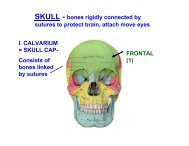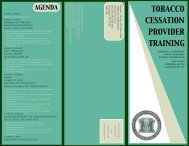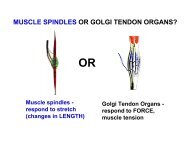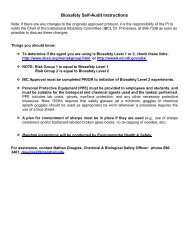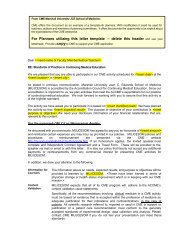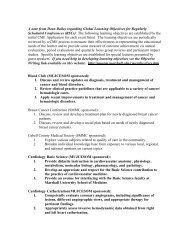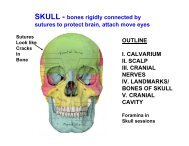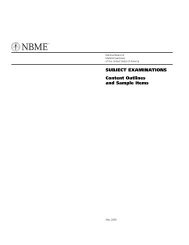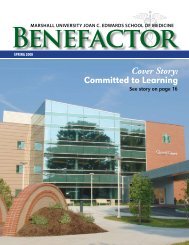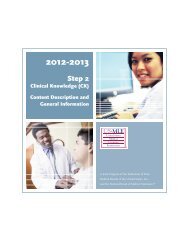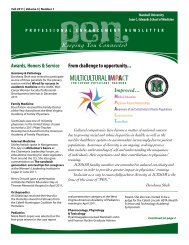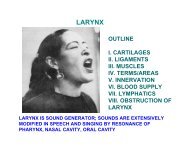FA 5 Progress Report WV-INBRE - Joan C. Edwards School of ...
FA 5 Progress Report WV-INBRE - Joan C. Edwards School of ...
FA 5 Progress Report WV-INBRE - Joan C. Edwards School of ...
- No tags were found...
Create successful ePaper yourself
Turn your PDF publications into a flip-book with our unique Google optimized e-Paper software.
Program Director/Principal Investigator (Last, First, Middle): Rankin, Gary O 59GENETIC BASIS FOR <strong>FA</strong>MILIAL COMBINED HYPERLIPIDEMIA (FCHL) (0026)TYPE: Research Subproject%IDeA $: 1.000% IDeA $: 22,500INVESTIGATOR, DEGREEPrimerano, Donald A PHDBaria, Kim RNDementieva, Yulia PHDDenvir, James PHDFan, Jun BS, PHDHenderson, Angela RNNeal, William MDOmar, Hatim <strong>FA</strong>AP, MDDEPARTMENTBiochemistry &MicrobiologyHealth Research AndEducationMathematicsBiochemistry AndMicrobiologyBiochemistry &MicrobiologyClinical TrialsPediatric CardiologyPediatricsNON-HOST INSTITUTION: STATE,COUNTRYCharleston Area Medical Center, WvUsaEmmanuel College, Ma UsaCharleston Area Medical Center, WvUsaWest Virginia University , Wv UsaUniversity Of Kentucky, Ky UsaTotal # human subjects expected for entire study: 500Total # human subjects enrolled to date: 363SUBPROJECT DESCRIPTIONFamilial Combined Hyperlipidemia (FCHL) is generally defined by elevation <strong>of</strong> LDL cholesterol andtriglycerides. FCHL affects 0.5-2% <strong>of</strong> the population <strong>of</strong> Westernized societies and is one <strong>of</strong> the mostcommon genetic lipid disorders in patients with coronary artery disease. Recent segregation analyses andlinkage studies suggest an oligogenic mode <strong>of</strong> inheritance. Our long-range goal is to gain an understanding<strong>of</strong> the molecular and cellular events that lead to disregulation <strong>of</strong> cholesterol and triglyceride levels. Theoverall objective <strong>of</strong> this project is to identify gene(s) that predispose to FCHL using family-based linkageanalysis and association methods. By studying juvenile-based families we hope to identify a form <strong>of</strong> thedisease with higher heritability. We will also study families that are based on affected adults. The centralhypotheses are that there are specific genes that confer susceptibility to FCHL and that novel gene defectscontribute to juvenile FCHL. The rationale is that once these susceptibility genes have been identified, wewill better understand the molecular pathogenesis in individuals and be able to provide rational, personalizedtreatments or preventative measures can be implemented and tailored to the actual genetic defect. We planto accomplish the objective <strong>of</strong> this application by pursuing the following two specific aims:1. Identify novel FCHL loci by linkage analysis on a genome-wide set <strong>of</strong> markers.2. Perform genetic fine mapping on the susceptibility loci in order to narrow the region <strong>of</strong> interest andidentify variants that encode defective products.The proposed work is innovative because we will analyze Appalachian families based on affected juvenilepatients. These patients have greater genetic risk <strong>of</strong> developing CVD than adult FCHL patients. It is ourexpectation that this analysis will uncover novel loci and specific genes at those loci that contribute to thedevelopment <strong>of</strong> FCHL. Our findings will be significant because they will further our understanding <strong>of</strong> thepathogenesis <strong>of</strong> vascular disease and because these susceptibility genes represent new targets forpreventative and therapeutic interventions.SUBPROJECT PROGRESSFCH <strong>Progress</strong> <strong>Report</strong> Y111. IntroductionFamilial Combined Hyperlipidemia (FCH) is a complex genetic disease in which affected familyPHS 2590 (Rev. 06/09)Continuation Format Page



